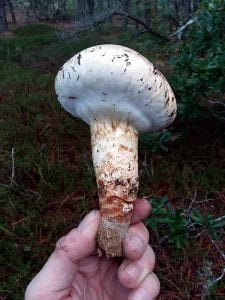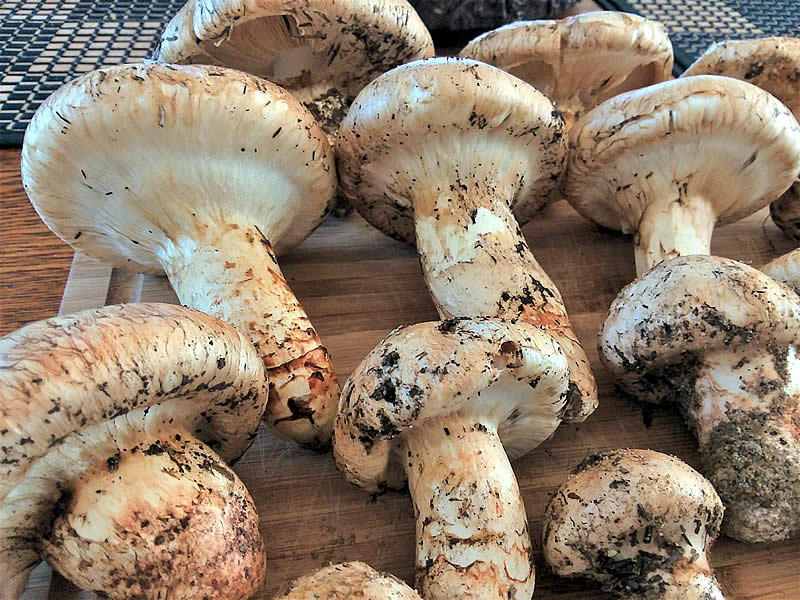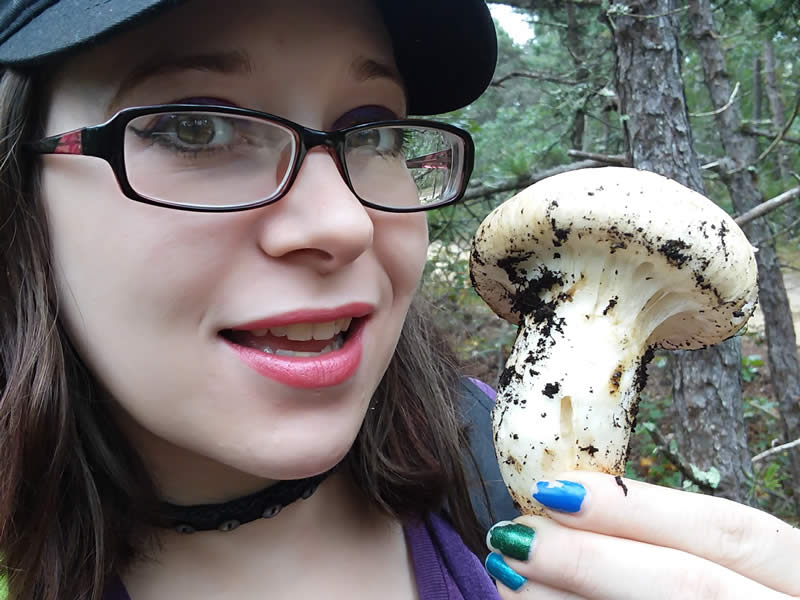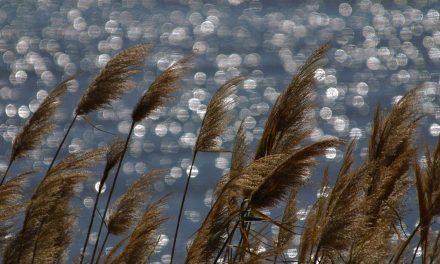Even among the lucky Americans who know about edible wild mushrooms, there are few who know that the season continues after October. From our explorations over the years, Emily and I have learned to simply add an extra layer of clothing to keep going and keep looking. Because, while the first morning of frost may signal the end for some species, it signals the beginning for others. There are mushrooms that thrive only in the low temperatures of late fall.
No doubt you’ve heard of the Shiitake mushroom, and maybe also the Maitake (which Americans call Hen of the Woods). You can see from those words that “take” is Japanese for “mushroom”. Literally, Shiitake means “oak mushroom”, and Maitake means “dancing mushroom”. Today’s topic, the Matsutake, is the “pine mushroom”. Yes, Matsutake grows under evergreens…but to identify it, you need to know more than just its habitat. Many species are found under pines, and not all of them are safe to eat. This brings up an important point, something I have to mention before we go on. I’ll be discussing edible wild mushrooms here, but this article is not meant to fully instruct you about how to identify them. Photos are included but remember comparing a mushroom to a photograph does not mean you have identified it correctly. Additional knowledge and experience are required. We can teach you; that’s what The Mushroom Hunting Foundation exists for! But for now, just enjoy the article and let me introduce you to one of our favorite late fall mushrooms.
The Matsutake has an aroma like nothing else; it’s deep, spicy, and pungent. The best description I’ve heard is that it smells like Hot Tamales—you know, those chewy cinnamon red-hot candies—combined with gym socks. That’s right, gym socks. To be more specific, unwashed gym socks. Hungry yet? Well, I am! Matsutake is an acquired taste…and once you’ve acquired it, the pungent smell is mouth-watering. There’s a reason the Japanese pay top dollar for these fungi.
When I first tried it, I found it to have a tough and stringy texture…but I had sliced it up at the normal thickness used for wild mushrooms (between 1/8” and 1/4” thick). Emily said “I read that they slice Matsutake really thin in Japan, and I think I just figured out why: because thin slicing defeats the stringy texture. It allows you to focus on the flavor.” Well, of course the Japanese would know best! They have appreciated the Matsutake for ages. Reading about how they honor it with various traditions, I had an impression of obsessive overkill…but once I tried it, I “got it”. Now Emily and I have the obsession too.
 You can find Matsutake in Chinese recipes and in other Asian cuisine as well. Its uses can be spectacular, or more subtle. For example, you can lay some Matsutake slices on a fish fillet, then wrap it in tin foil and bake it; the fillet has now been steamed in their unique spiciness, and that flavor remains strong even if you remove the mushroom slices. It’s fantastic. But so far, my favorite Matsutake recipe is a Japanese dish called Gohan Rice. I don’t think I could even begin to describe its special combination of flavors.
You can find Matsutake in Chinese recipes and in other Asian cuisine as well. Its uses can be spectacular, or more subtle. For example, you can lay some Matsutake slices on a fish fillet, then wrap it in tin foil and bake it; the fillet has now been steamed in their unique spiciness, and that flavor remains strong even if you remove the mushroom slices. It’s fantastic. But so far, my favorite Matsutake recipe is a Japanese dish called Gohan Rice. I don’t think I could even begin to describe its special combination of flavors.
In Japan, the whole system of how Matsutake mushrooms are graded for sale (Grade A, Grade B, etc.) seems to be based on what stage of development delivers the most aroma. The species has gills under its cap, and the gills give off the strongest smell. But when the mushroom is young, like those pictured here, those gills are covered up by a protective membrane called a partial veil. So, this veil is holding in a puff of very fragrant air! As the mushroom matures and the cap opens up, the partial veil breaks open…allowing the smell to dissipate somewhat. Even though it is substantially larger, the older mushroom is less preferable, because it is less aromatic. A mushroom that’s too young is also less aromatic. So, we have a Goldilocks situation. “Just right”—in other words, Grade A—means the veil is just starting to be stretched, but not yet close to breaking. That’s when the chef can be most confident in the strength of its fragrance.
When you are hunting these mushrooms and identifying them, that special scent is actually an important factor. If the supposed Matsutake you found doesn’t have that smell, well…maybe it’s not really what you think it is! But consider this too: if you’re having a good hunt, and you have now found and picked several, your hands themselves will begin to smell like Matsutake…and therefore, so will every mushroom you pick up. Fortunately, in addition to the scent, the species has a combination of other features that make it unique. It’s not one of the easy ones—we don’t recommend it to beginners—but with details about its stature, coloration, veil, and gills, an experienced mushroom hunter can confirm its identity. It’s never based on sense of smell alone.
On one particularly bountiful hunt, while Emily and I were returning to the van to put our Matsutake in the cooler (and go back into the woods for more), I suddenly had an idea. I cut a piece of cap meat into two little pieces and made Matsutake-scented nose plugs. The first ones I cut were too thick, and blocked my nose completely; but smaller slivers worked perfectly. Every inhale brought an intense, spicy blast of Matsutake. It felt like that forest was part of heaven.

We are lucky to have any of the right tree species for Matsutake in America at all, because unfortunately, the red pine forests of Japan were afflicted by a devastating tree disease—a blight that ultimately wiped out most of their Matsutake habitat. Since then, Japan has been importing Matsutake from the western USA. We find them on the East Coast too, but that extra distance from Japan increases shipping time and costs, cutting into the value. The East Coast ones are best enjoyed right here! We love hunting and collecting them together. Emily has learned a number of Japanese recipes, just for celebrating this one, super-cool ingredient.
Consider for a moment that one single species is all we’ve been discussing. The world of wild mushrooms is vast; it puts the familiar options at the supermarket to shame. Mushroom hunters get to enjoy a whole smorgasbord of incredible flavors that most people will never even have a chance to try. Each of these little-known treasures has countless culinary uses still waiting to be discovered, too, which is why our classes encourage creative cooking. There are species that we’ve tried on just one lucky occasion, and others we’ve been able to enjoy a hundred times or more, experimenting with them extensively. Emily and I have eaten over 250 mushroom species. Most of them are just as unique and wonderful as the Matsutake, and equally worthy of discussion and celebration.
There are other reasons why mushroom hunting is so enjoyable. Mycology—the science that makes it possible to identify mushrooms correctly, and to enjoy them safely—is a fascinating subject to learn about. And the hunt itself, of course, is also a ton of fun. Get into it! You won’t be disappointed.
by Ryan Bouchard
















